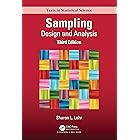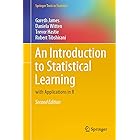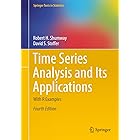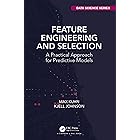| Kindle Price: | $114.00 |
| Sold by: | JOHN WILEY AND SONS INC Price set by seller. |
Your Memberships & Subscriptions

Download the free Kindle app and start reading Kindle books instantly on your smartphone, tablet, or computer - no Kindle device required.
Read instantly on your browser with Kindle for Web.
Using your mobile phone camera - scan the code below and download the Kindle app.

Follow the author
OK
Sampling 3rd Edition, Kindle Edition
"This book has never had a competitor. It is the only book that takes a broad approach to sampling . . . any good personal statistics library should include a copy of this book."
—Technometrics
"Well-written . . . an excellent book on an important subject. Highly recommended."
—Choice
"An ideal reference for scientific researchers and other professionals who use sampling."
—Zentralblatt Math
Features new developments in the field combined with all aspects of obtaining, interpreting, and using sample data
Sampling provides an up-to-date treatment of both classical and modern sampling design and estimation methods, along with sampling methods for rare, clustered, and hard-to-detect populations. This Third Edition retains the general organization of the two previous editions, but incorporates extensive new material—sections, exercises, and examples—throughout. Inside, readers will find all-new approaches to explain the various techniques in the book; new figures to assist in better visualizing and comprehending underlying concepts such as the different sampling strategies; computing notes for sample selection, calculation of estimates, and simulations; and more.
Organized into six sections, the book covers basic sampling, from simple random to unequal probability sampling; the use of auxiliary data with ratio and regression estimation; sufficient data, model, and design in practical sampling; useful designs such as stratified, cluster and systematic, multistage, double and network sampling; detectability methods for elusive populations; spatial sampling; and adaptive sampling designs.
Featuring a broad range of topics, Sampling, Third Edition serves as a valuable reference on useful sampling and estimation methods for researchers in various fields of study, including biostatistics, ecology, and the health sciences. The book is also ideal for courses on statistical sampling at the upper-undergraduate and graduate levels.
- ISBN-13978-0470402313
- Edition3rd
- PublisherWiley
- Publication dateFebruary 8, 2012
- LanguageEnglish
- File size24801 KB
Kindle E-Readers
- Kindle Paperwhite
- Kindle Paperwhite (5th Generation)
- Kindle Touch
- Kindle Voyage
- Kindle
- Kindle Oasis
- All new Kindle paperwhite
- All New Kindle E-reader
- Kindle Oasis (9th Generation)
- Kindle Paperwhite (10th Generation)
- Kindle Paperwhite (11th Generation)
- All New Kindle E-reader (11th Generation)
- Kindle Scribe (1st Generation)
- Kindle (10th Generation)
- Kindle Oasis (10th Generation)
Fire Tablets
Free Kindle Reading Apps
Customers who bought this item also bought
Editorial Reviews
From the Inside Flap
"This book has never had a competitor. It is the only book that takes a broad approach to sampling . . . any good personal statistics library should include a copy of this book." —Technometrics
"Well-written . . . an excellent book on an important subject. Highly recommended." —Choice
"An ideal reference for scientific researchers and other professionals who use sampling." —Zentralblatt Math
Features new developments in the field combined with all aspects of obtaining, interpreting, and using sample data
Sampling provides an up-to-date treatment of both classical and modern sampling design and estimation methods, along with sampling methods for rare, clustered, and hard-to-detect populations. This Third Edition retains the general organization of the two previous editions, but incorporates extensive new material—sections, exercises, and examples—throughout. Inside, readers will find all-new approaches to explain the various techniques in the book; new figures to assist in better visualizing and comprehending underlying concepts such as the different sampling strategies; computing notes for sample selection, calculation of estimates, and simulations; and more.
Organized into six sections, the book covers basic sampling, from simple random to unequal probability sampling; the use of auxiliary data with ratio and regression estimation; sufficient data, model, and design in practical sampling; useful designs such as stratified, cluster and systematic, multistage, double and network sampling; detectability methods for elusive populations; spatial sampling; and adaptive sampling designs.
Featuring a broad range of topics, Sampling, Third Edition serves as a valuable reference on useful sampling and estimation methods for researchers in various fields of study, including biostatistics, ecology, and the health sciences. The book is also ideal for courses on statistical sampling at the upper-undergraduate and graduate levels.
From the Back Cover
"This book has never had a competitor. It is the only book that takes a broad approach to sampling . . . any good personal statistics library should include a copy of this book." ―Technometrics
"Well-written . . . an excellent book on an important subject. Highly recommended." ―Choice
"An ideal reference for scientific researchers and other professionals who use sampling." ―Zentralblatt Math
Features new developments in the field combined with all aspects of obtaining, interpreting, and using sample data
Sampling provides an up-to-date treatment of both classical and modern sampling design and estimation methods, along with sampling methods for rare, clustered, and hard-to-detect populations. This Third Edition retains the general organization of the two previous editions, but incorporates extensive new material―sections, exercises, and examples―throughout. Inside, readers will find all-new approaches to explain the various techniques in the book; new figures to assist in better visualizing and comprehending underlying concepts such as the different sampling strategies; computing notes for sample selection, calculation of estimates, and simulations; and more.
Organized into six sections, the book covers basic sampling, from simple random to unequal probability sampling; the use of auxiliary data with ratio and regression estimation; sufficient data, model, and design in practical sampling; useful designs such as stratified, cluster and systematic, multistage, double and network sampling; detectability methods for elusive populations; spatial sampling; and adaptive sampling designs.
Featuring a broad range of topics, Sampling, Third Edition serves as a valuable reference on useful sampling and estimation methods for researchers in various fields of study, including biostatistics, ecology, and the health sciences. The book is also ideal for courses on statistical sampling at the upper-undergraduate and graduate levels.
About the Author
Steven K. Thompson, PhD, is Shrum Chair in Science and Professor of Statistics at the Simon Fraser University. During his career, he has served on the faculties of the Pennsylvania State University, the University of Auckland, and the University of Alaska. He is also the coauthor of Adaptive Sampling (Wiley).
Product details
- ASIN : B0078XBZ6K
- Publisher : Wiley; 3rd edition (February 8, 2012)
- Publication date : February 8, 2012
- Language : English
- File size : 24801 KB
- Text-to-Speech : Enabled
- Screen Reader : Supported
- Enhanced typesetting : Enabled
- X-Ray : Not Enabled
- Word Wise : Not Enabled
- Sticky notes : On Kindle Scribe
- Print length : 469 pages
- Best Sellers Rank: #2,376,378 in Kindle Store (See Top 100 in Kindle Store)
- #1,533 in Probability & Statistics (Kindle Store)
- #7,929 in Probability & Statistics (Books)
- Customer Reviews:
About the author

Discover more of the author’s books, see similar authors, read author blogs and more
Customer reviews
Customer Reviews, including Product Star Ratings help customers to learn more about the product and decide whether it is the right product for them.
To calculate the overall star rating and percentage breakdown by star, we don’t use a simple average. Instead, our system considers things like how recent a review is and if the reviewer bought the item on Amazon. It also analyzed reviews to verify trustworthiness.
Learn more how customers reviews work on AmazonCustomers say
Customers find the book a good reference for sampling approaches and easy to understand. They also appreciate the good R examples with each chapter.
AI-generated from the text of customer reviews
Customers find the book on sampling approaches to be a good reference. They also say it's useful for more advanced methods and has exercises with some answers in the back.
"It is a very good book, but not stand-alone. I recently taught with this textbook for a graduate research design course for the social sciences...." Read more
"Great book on sampling approaches... would be 5 stars if there were not so many mistakes in the formulas in text!..." Read more
"Great book -- very user friendly, has exercises with some answers in the back. I wouldl recommend to anyone learning sampling." Read more
"Great reference and easy to understand. Must have for any stats major! Good R examples with each chapter. Highly recommend!" Read more
Customers find the book easy to understand, clear on information, and accessible. They also appreciate the good R examples with each chapter.
"...the different types of sampling are helpful, and the code is understandable to someone who isn't a complete expert at R. The examples help reinforce..." Read more
"...I love this book. It's concise, consistent, and accessible. It really feels like the author put a solid effort into every single section...." Read more
"The book is pretty clear on information and very easy to follow." Read more
"Great book -- very user friendly, has exercises with some answers in the back. I wouldl recommend to anyone learning sampling." Read more
-
Top reviews
Top reviews from the United States
There was a problem filtering reviews right now. Please try again later.
The are mathematical symbols that fail to translate from print to the Kindle edition. One obvious example is \bar{M} translates as "M". In a nutshell, this happens so often that the Kindle should come with a warning and discounted price!
Note that the errors I describe go beyond those in the print edition.
Top reviews from other countries
Given the high price for such a small book and its intended use as a reference text, it is unfortunate/shameful that there are no errata available for this textbook online.









